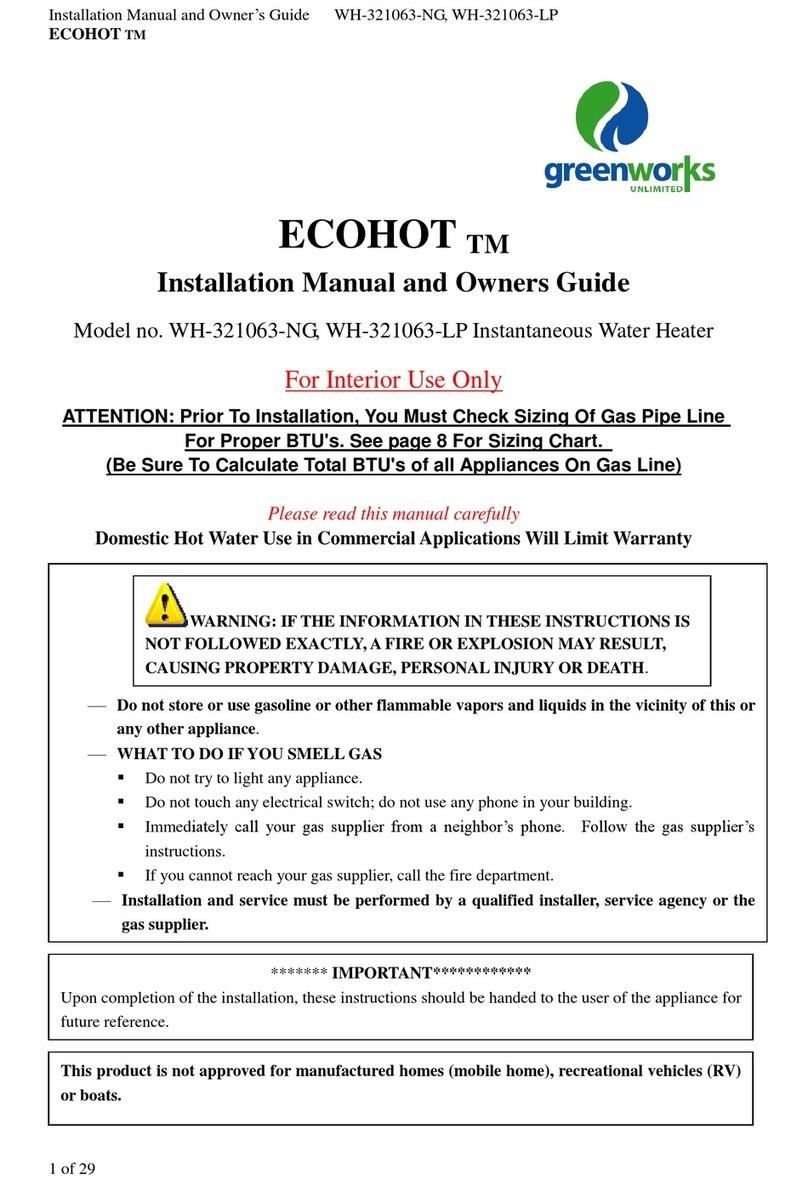Installation Manual and Owner’s Guide WH-201061-NG, WH-201061-LP
ECOHOT TM
7 of 29
Gas Supply
- It is recommended that the Natural Gas & LP Pipe be standard weight or steel (galvanized or
black) or yellow brass (containing not more than seventy five (75) percent copper). Approved PE
pipe may be used in exterior buried piping systems. All such pipe shall be either new or
previously used for no other purpose than conveying gas; and must be in good condition and free
from internal obstructions. Burred ends shall be reamed to the full bore of the pipe. All fittings used
shall be of malleable iron, yellow brass, or approved plastic fittings. (See gas chart ).
THESE FIGURES ARE FOR ECOHOTTM SUPPLY ONLY; ALL OTHER APPLIANCES IN
THE BUILDINGWILLNEED TO BE INCLUDED IN THE PIPE SIZING.
National Fuel Gas Code requires that a sediment trap (trip leg) be installed on gas appliances not so
equipped. The drip leg must be accessible and not subject to freezing conditions. Install in
accordance with the recommendation of the local gas supplier.
WARNING: The heater must be disconnected from the gas supply piping system at test
pressures testing of that system during any pressure testing of that system at test pressure in excess
of 0.5 PSI The water heater must be isolated from the gas supply piping system by closing the
manual shutoff valve during any pressure testing of the gas supply piping system at test pressures
equal to or more than 0.5 PSI.
This water heater includes a pressure regulator and must not be operated at gas supply pressures in
excess of 0.5 PSI. If overpressure has occurred, such as through improper testing of the gas lines or
malfunction of the supply system, the gas valve and regulator must be checked for safe operation.
Make sure that the regulator vent is protected against blockage.
For Natural Gas, the minimum inlet gas pressure is 6 inches W.C.(1.5kPa). For LPG, the minimum
inlet gas pressure is 10 inches W.C.(2.5kPa)
When your connections are made, check for gas leaks at all joints (this includes all existing piping).
Apply soapy water to all gas fittings and gas valve. Soap bubbles are a sign of a leak.
NOTE: No substance other than air, carbon dioxide or nitrogen can be introduced into the gas
piping.
NOTE: If you have a leak, shut off the gas. After verifying the leak, tighten appropriate fittings to
stop leak. Turn the gas on and check again with a soapy solution. Never test for gas leaks using a
match or flame.
Gas Piping, Connections and Gas Regulator
Before connecting the gas supply, check the rating plate on the right side of the right front cover to
be sure that the heater is rated for the same gas to which it will be connected.
In the United States: The installation must conform with local codes or, in the absence of local
codes, the National Fuel Gas Code ANSIZ223.1/NFPA54.
In Canada: The installation should confirm with CGAB149 INSTALLATION CODES and/or local
installation codes.




























